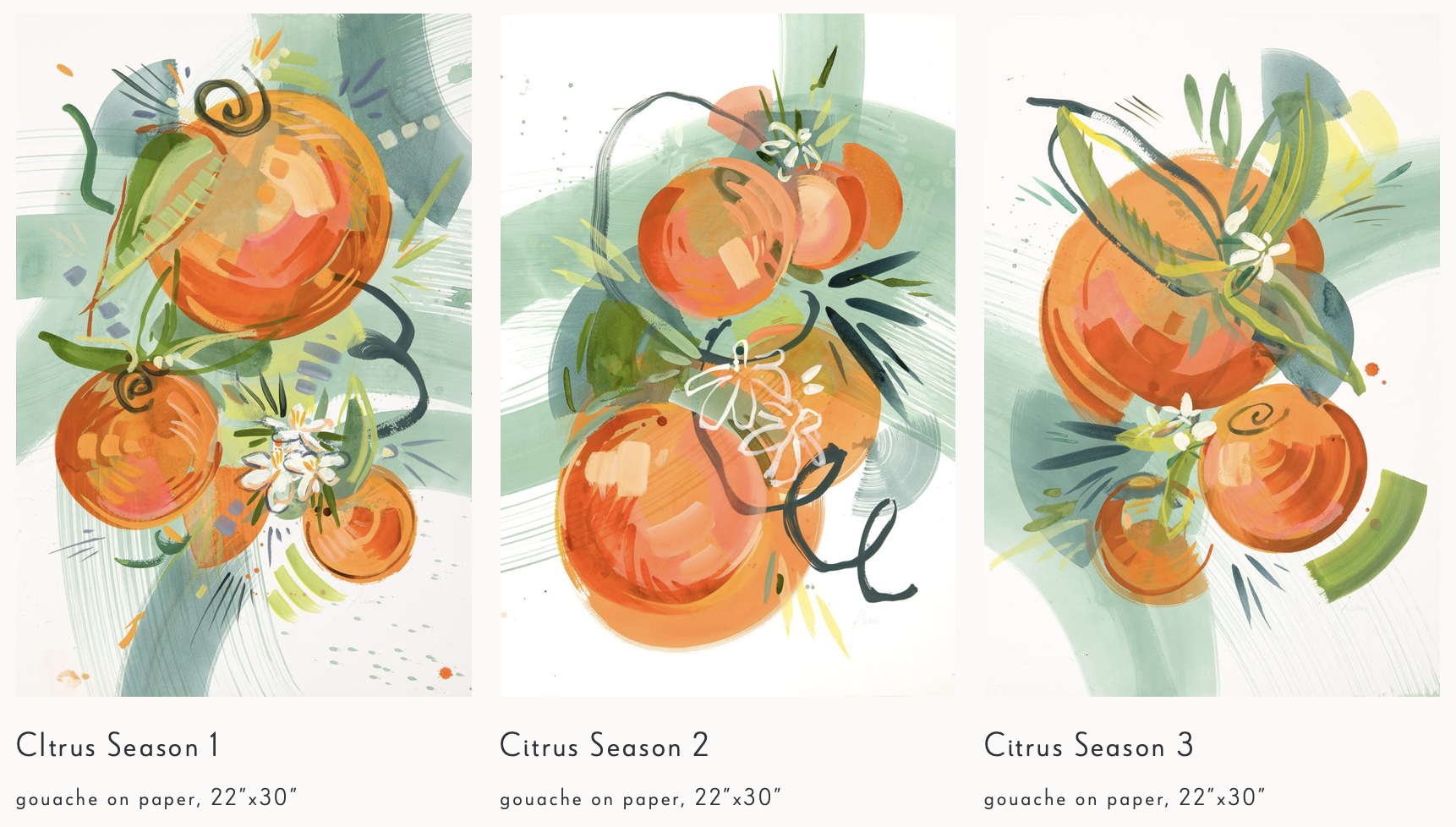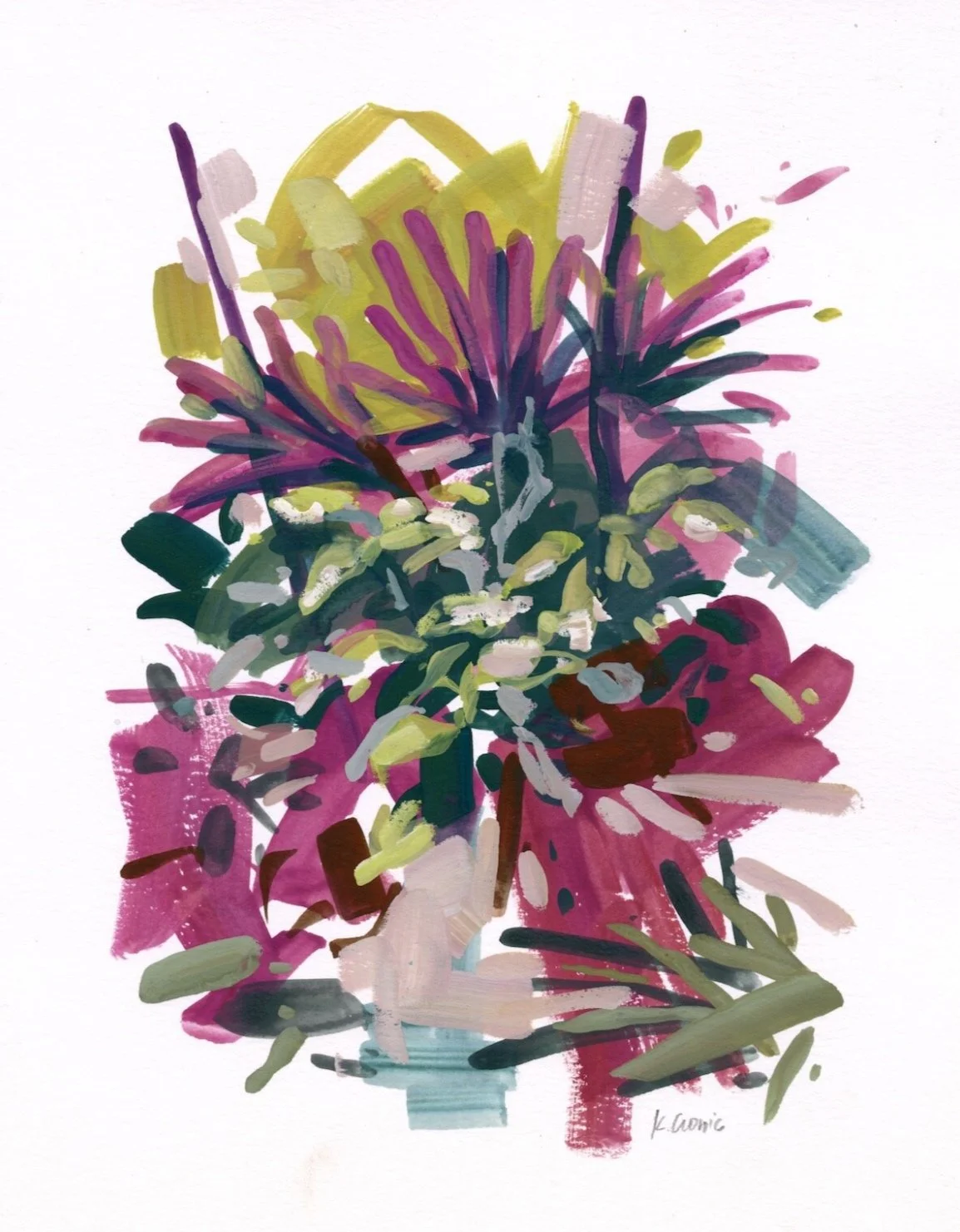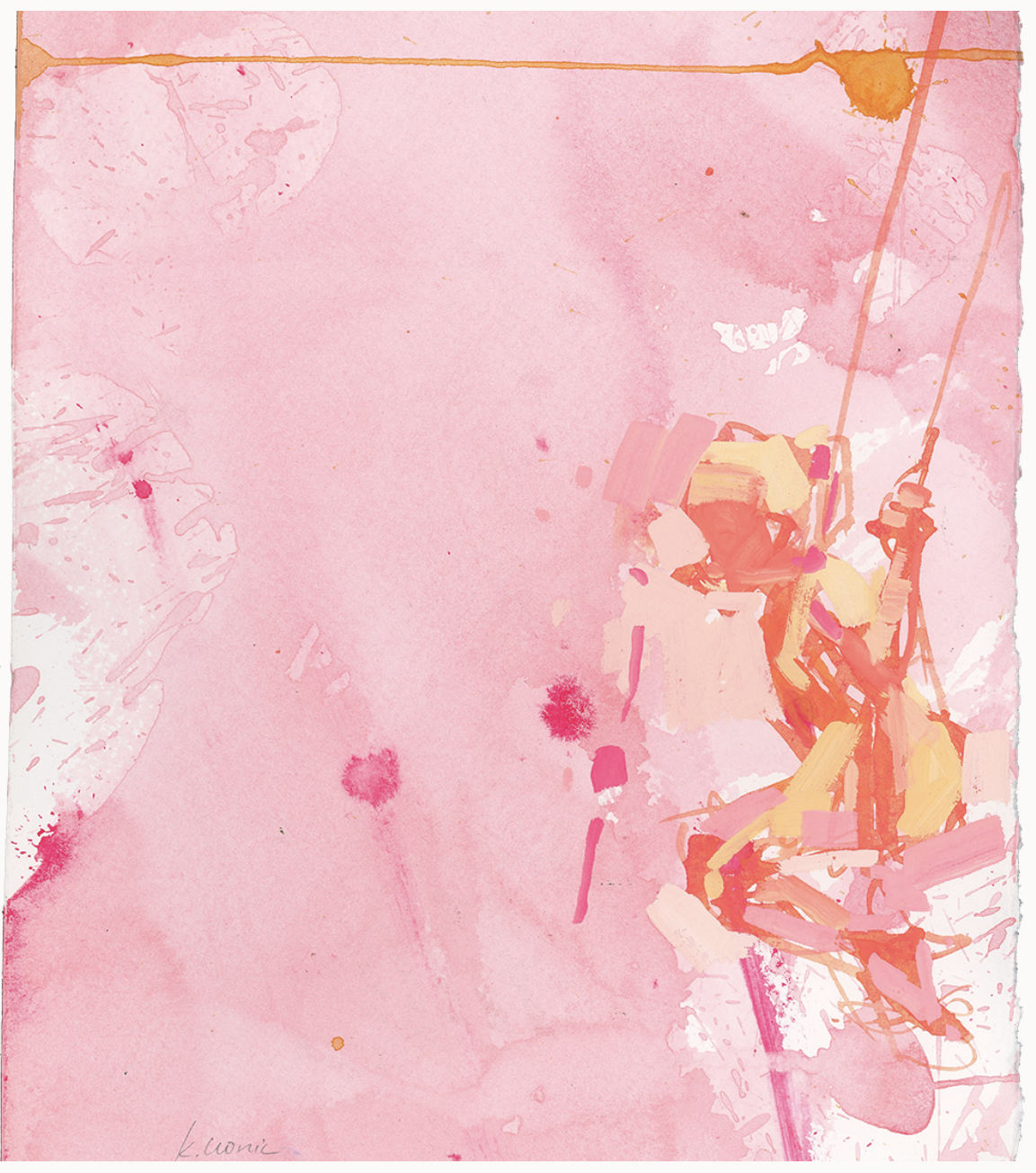THE CATCH NEWSLETTER
September 2024
Theme
September’s bird of the month is the swallow, a songbird that can be found all over the world.
Local to Jacksonville, artist Kristin Cronic uses the swallow as the logo for her website, reflecting on the bird as “symbols that we were close to coming home.”
Talon Update
We are so happy to begin this new semester of Talon Review! Thank you to everyone who came to our first Open Mic Night of the semester!
We are seeking submissions for our next issue until November 1st. Our editors are enjoying seeing all the submissions come in. If you are interested in having your work in our next issue, see our Submittable page for more information!
Pens and Paints: An Interview with a Local Creative, Kristin Cronic
Interview conducted by Hannah Frison
Introduction
For this month’s newsletter, we have a transcript of a very insightful interview with Jacksonville-based artist and teacher, Kristin Cronic. In this interview, Cronic walks us through her experiences as an artist and how they intertwine with her way of life, self-identity, and her relationship with the world around her. Please enjoy the discussion, and check out her artwork at the links below:
Website: https://www.kristincronicart.com/
Instagram: https://www.instagram.com/kristinraecronic
Pinterest: https://www.pinterest.com/kristincronic/
Facebook: https://www.facebook.com/kristincronicart
If you have any questions for Mrs. Cronic, please reach her at hello@kristincronicart.com.
Interview Transcript with Mrs. Kristin Cronic
HANNAH: Thank you Mrs. Kristin Cronic for being able to interview with “The Catch” newsletter! Would you mind giving a brief introduction of yourself?
KRISTIN: Sure, thank you for having me! My name is Kristin Cronic. I am [an] artist, primarily, mostly painting. I also teach drawing at Jacksonville University, and I am a mother of three kids. I was a Navy Veteran; I am a Navy Veteran, and now I work primarily as a teacher and as a painter doing a variety of things.
HANNAH: Well, first I just wanted to say I really liked the “Citrus Season.”
KRISTIN: Oh thanks!
HANNAH: I really liked the color scheme there. It was just real vibrant!
KRISTIN: Thank you!
HANNAH: I am also just kinda into oranges right now, so…
KRISTIN: Yep, me too!
“Citrus Season” from Kristin Cronic’s website.
HANNAH: But my first question for you is: how do you encompass pieces of yourself and your personal life story in your artwork?
KRISTIN: Oh, that’s a great question. I have always found art-making as a bit of a meditative process, and it’s a way to kind of, just connect with myself, and when I start there, it inevitably comes out. You know we are multifaceted people, and therefore, if art is my outlet, it’s pretty much my only outlet. I know some people like singing or dance and a variety of things. For me, it’s pretty much just visual art, which turns into bodies of work that kind of touch on different areas that I will rotate around, depending on how I’m feeling and what I’m hoping to work on.
It’s always an interesting balance of being a working artist with external pressures and expectations and deadlines. And then, you know, sometimes that’s at odds with maybe where I’m at a certain moment. So, if I’m in a state where I’m having to make things that don’t quite feel like myself at the moment, I will oftentimes go to a sketchbook and, you know, get that out in a small way and work on what I need to work on. But inevitably, there’s elements of play and curiosity and then there’s tangents; I’m ADHD so that happens a lot. And then there’s work that’s more thoughtful and conceptual, and I don’t like to stay in one for too long at any given point. I like to kinda have a couple different ways to move in the studio.
HANNAH: Okay, just a follow up question on that. I know you just said that you were ADHD, and I was wondering are there pros and cons to that in terms of how you do your art?
KRISTIN: Absolutely! I have come over a time to really love my brain for what it can do. I would say the pros are…ideas flow very freely. Sometimes, I can’t get them out quick enough. It’s pretty rare that there isn’t some new curiosity or question that I want to explore! I do have some times [when] I’m in a state where I am feeling really bored. That’s kind of a red flag that something’s off in my life, like, I probably am over-committed in some way. So, I’d say that’s probably my favorite positive to it.
I also do live wedding paintings as means to make predictable income, ‘cause art can be very unpredictable, and I think it’s a huge benefit in that, because the ADHD brain likes to hyper-focus and it also likes pressure. And so, painting a couple on their wedding day is all of those things, and I just find it kinda just, like, scratches that part of my brain and I love it! It makes me, you know, [get to where] I can focus and get something done, but the negatives are that it can be very hard to prioritize and to understand that I have to still show up in ways that I committed.
And at times, as I have mentioned before, that can be at odds with my practice ‘cause sometimes art is how I’ll regulate. But when there’s now added pressure on that outcome, it can sometimes be at odds, so I just have to take breaks and check in with myself. And then impulsivity is a pretty big one with ADHD, and that’s something over the years I’ve learned just to set limits on when I say yes to things. So I try to journal and sleep on yeses before I say them, you know, because it’s just easier for me to. If it’s exciting I want to do it, I don’t always have the easiest time connecting what’s gonna wind up hurting me in the long run. So by pausing and taking a little bit longer to say yes, it helps me avoid over committing.
HANNAH: Yeah, definitely. I feel like, even, you know, with or without ADHD, it’s always good to just think about saying yes to things before you actually say yes ‘cause you get too much dip on your chip and your chip breaks and now you just have a piece of chip stuck in your dip, and that sucks.
KRISTIN: Yeah. That’s the best analogy I’ve ever heard!
Art in progress. Photos from Kristin Cronic’s website.
HANNAH: So my second question is pretty simple. Well, maybe not, but what is your favorite piece you have done and why?
KRISTIN: Oh gosh. I don’t know! No, I think honestly, I… my husband sometimes calls me a “mama emu.” He grew up on an emu ranch, and if a female emu lays eggs, she will actually stomp on them, so the male actually protects the eggs. So, if I feel done with a piece and it sticks around a little too long, I will just paint over it. But there are a few that I can’t, and so with time, there’s probably two to four a year that I have hung on to or sold, but I would’ve hung on to if they hadn’t sold that feel just, like, relevant pieces in my growth as an artist and a human. And they may not necessarily look like something special to somebody else, but to me, that was a moment of clarity or of breakthrough in my practice. And so, I think there’s probably two or three to answer your question. It usually takes me a little bit of time, like a year or so, to be able to identify them on which those are.
HANNAH: Okay! That’s fine. It’s okay to not have a favorite or to have favorites, but it switches every year or so, that’s totally okay. My next question is what would you say is your biggest source or sources of inspiration for your artwork?
KRISTIN: That’s a great question! The first is probably, visually, very obvious. I get a lot of inspiration from nature and the reasons why have changed over the years. But, what hasn’t changed is this just continual intrigue in what I see outside. And the second thing is experiencing motherhood and my children. But if I’m being honest, it’s more about my experience as a mother and watching them grow up and how much that’s taught me and continues to teach me, so that’s probably the second one.
A few of Kristin Cronic’s expressionisms, from her website.
HANNAH: Okay, and then a follow up question on that. I know that I saw some pencil sketches on your website, so it sparked a question of had you ever explored any different art style? Like I said, I know you had the pencil sketches, but if you could go into a little more of your art style and then also, if you ever thought about pursuing a different art style. If you tried one and said, “this isn’t it” and then you…
KRISTIN: I love that question! I REALLY pushed back on the idea that artists have to find a style and stick to it. I think that it works great for some people, and if that’s you, honestly I’m a little bit jealous because it’s easier to…in many ways, like, people know what to expect when you have that in a good way. I get bored easily. So I found different styles tend to come out in different ways of making art, but in general I do. I will say I started learning painting very attracted to the impressionists. There was something very immediate about it and not precious about it that I really loved! But then as of, like, now, I would say for the most part I range between impressionism and expressionism, which is just a little bit more exaggerated, maybe stronger color.
Every once in a while I will dip into abstraction, but I typically am abstracting something that’s real. I’m not just doing splash paint, which I think is wonderful. It’s just for me. It’s not the way I’m thinking. But then, every so often I have done these much more clean, realistic pencil drawings, and those typically are just moments for me to quiet down and observe and meditate, and just that process of making marks very, very slowly.
I almost don’t see it as a style as it is a process and a meditation, and it’s just, like, these moments that are grounding and enjoyable ‘cause…to be abstracting and expressing it is a quicker mark; it happens fast, but it also comes from deep in your gut and it can be a pretty emotional thing. It’s almost like a flower that blooms once a year; it’s like this burst of energy, but you can’t sustain that. And so that methodical, slower pencil drawing tends to be a way to kind of like just build that, you know, [to] kind of allow that part to kind of heal and regenerate as energy is expressed in a different way.
Graphite drawings from Kristin Cronic’s website.
HANNAH: Okay, that’s actually pretty interesting. I never thought about drawing real, real detailed to like, kind of, promote the big bang. It’s just interesting to see how everybody’s artistic process is different and how they process things, that’s really cool! Um, my next question for you is if you had a chance to talk to your past/younger self, what would you talk about with them, and then what would you say about your life now compared to then?
KRISTIN: Oooh. I put a lot of pressure on myself when I was younger, and I still do. And, I think I would tell her that it’s okay to just be and to rest in that. Constantly driving is not healthy and not sustainable. The irony is my current self needs to hear that too! Is that the question or was there another part to it?
HANNAH: Oh, well I mean that was the question; it was just asking, like, what would you talk about with them and then what would you say about your life now compared to then?
KRISTIN: I would say with it now, I always wanted to be a mother, and I feel very blessed that I got to be one and I got to have three awesome kids, so you know, those things when I was younger, and this is probably typical but you know, the feelings of being insecure or angst about feeling connected, accepted. It’s like, you know, at the end of the day, you find those people that you don’t really care what other people are doing when you're with them. And be yourself. Be kind… we’re all in this together as humans, and we are all trying our best. I really believe that, so it’ll be okay!
HANNAH: Totally, and then next question: on your website you mention having to overcome imposter syndrome. Do you mind expanding on how you became more comfortable embracing yourself as an artist?
KRISTIN: Yes, that’s great! I did not go to art school to learn how to draw and paint. I learned from artists that had workshops or classes or books. We didn’t have as much online when I was first starting, but I did learn a little bit online but just that. I studied engineering in school; I was in the navy, so it’s not like I was just in that [art] world, and it was a long time before I felt I could own that. And how I did that was just by doing it and continuing to show up and feeling more confident in my work, getting feedback, that feedback knocking me down, getting back up again; really just that. It’s just recognizing most people don’t know what they're doing, and that’s okay too!
Now I’m teaching at an art school. I did get my MFA later on, but I didn’t ever go to art school as an undergrad, so it’s, you know, ironic. But I'm like, you know what at the end of the day, I’m here to teach skills that I learned this way and now I get to give it to somebody in a curriculum format which is a lot more organized, recognizing that no one really ever knows what they are doing and that’s okay. And just show up and do your best, and if you like it, keep going! One day, you will feel comfortable. I don’t know when that day will come, but that’s okay, it's part of it.
“Swinging 2” and “Swinging Study 1” by Kristin Cronic, from her website.
HANNAH: Exactly. And then my last question would be what advice would you give to people starting to pursue art?
KRISTIN: I think to continuously reconnect with why you are pursuing art. Check in with yourself often a couple times a year; really think about it and evaluate if how you’re showing up is in line with that why. It doesn’t have to look like a professional career in terms of making money and all that stuff. Sometimes art can be an outlet, and I kind of think art should be shared. So, if you're making it, it doesn’t exist in a vacuum. You’ll grow as an artist if you share it in some way, whether it’s through exhibitions or Instagram…TikTok, whatever the kids use these days! I think that can be really good, but the success in art making happens when you make the work, not with what happens to it after, and I think I see a lot of…I felt this way for a while: like, if it doesn’t sell, then it’s a failure; I’m like, “no, no, no , no”, the work was a success whenever you finished it. Whenever you showed up to it or whenever you painted over…that’s also a success, like, that’s a thing!
So it’s finding that satisfaction in the process first ‘cause creativity is not a machine [that] just continuously just churns day after day after day, twelve hours a day. That’s not how this works. There are seasons. There are ebbs and there are flows, and there are things that look like rests and things that look like productivity. And so, I think that’s the main difference between being an artist and having a vocation in general is that it doesn’t necessarily follow those rhythms.
So checking in with yourself and creating that space. That space can look like a job. I was full time, but now I’m teaching and that was a choice. I really love having a little bit of pressure off my studio. I love seeing people. I love paying it forward. I love having a schedule that I can show up to that’s outside of my painting! I still prioritize painting, like it’s you know, something I still try to show up to every day, even if it’s just ten minutes. So, I think that’s what I would say. Find your satisfaction in the process and find ways to be a part of the art ecosystem that feel good to you and give yourself the space, if you need it. If it looks like a job, there is no shame in that!












